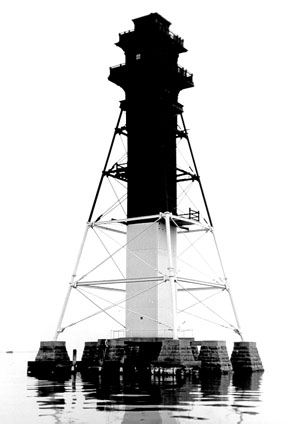Craighill Channel Lower Range Rear Light facts for kids
 |
|
| 1960 photograph of CraigHill Lower Range Rear Light (USCG) | |
|
|
|
| Location | Off Ramona Beach, Maryland (near Edgemere) in the Chesapeake Bay |
|---|---|
| Coordinates | 39°13′45″N 76°23′39″W / 39.2291°N 76.3942°W |
| Year first lit | 1873 (temporary lights), completed 1875 |
| Automated | 1964 |
| Foundation | stone pilings |
| Construction | iron skeleton tower |
| Tower shape | pyramidal with square central shaft |
| Height | 105 feet (32 m) |
| Range | 16 nautical miles (30 km; 18 mi) |
| Characteristic | Fixed white |
The Craighill Channel Lower Range Rear Light is a very tall lighthouse in Maryland. It is one of two special lights, called range lights, that help ships find their way. These lights mark the first part of the shipping path into Baltimore harbor. This lighthouse is actually the tallest one in all of Maryland!
Contents
History of the Craighill Light
Building a New Channel
Back in 1870, the United States Congress decided to spend $50,000 to make the shipping channel into Baltimore Harbor bigger. This was a lot of money at the time! The new channels were named after William Craighill. He was a member of the lighthouse board and helped plan where to dig.
Why Range Lights Were Needed
The first part of the new channel started near where the Baltimore Light is today. It went north before turning into the Patapsco River. To make sure ships could use this new path safely at night, new range lights were needed. Range lights work together: when a ship sees them lined up, it knows it's on the right course.
Choosing the Right Design
At first, builders thought about using screw-pile lighthouses. These lighthouses are built on long screws drilled into the seabed. But a very cold winter in 1872–1873 brought a lot of ice. This ice made them rethink their plans. Ice could easily damage screw-pile lighthouses.
So, for the front light, they built a small structure called a caisson. A caisson is like a big, watertight box sunk into the water. For the rear light, they built a strong base of nine stone piers. On top of these piers, they put up a tall, pyramid-shaped iron tower.
Challenges and Completion
Inside the iron tower, a central shaft made of wood held the stairs to the light. This shaft was covered with iron plates. A wooden house was built around the base of the light.
Building the foundations for both lights cost a lot of money. It used up all the money that Congress had given. This caused delays, and the lighthouses were not finished until 1875. For two years, temporary lightships were used instead to guide ships.
Changes Over Time
The wooden parts of the central shaft started to have problems with rotting almost right away. Even in 1994, a study suggested removing it. But after many repairs over the years, it is still there today.
The wooden house at the base of the light was reportedly rented out after the light became automated in 1923. This means it no longer needed a keeper living there. The house was finally taken down in 1938.



